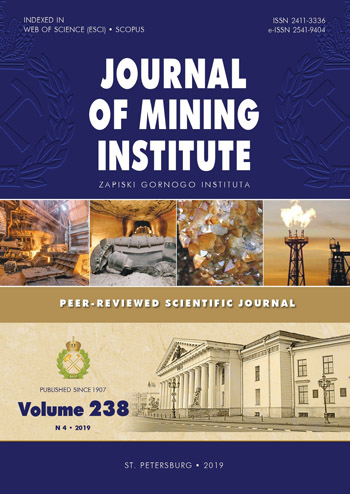Increase in Intake Capacity by Dynamic Operation of Injection Wells
- 1 — LLC «Gazpromneft Science & Technology Centre»
- 2 — LLC «Gazpromneft Science & Technology Centre»
- 3 — PJSC «Gazprom neft»
Abstract
The method of pumping water to compensate for fluid withdrawals from an oil formation in order to maintain formation pressure has long established itself as an effective technology and is widely used at oil and gas fields. At the same time, field operator is often faced with the problem of reduction in the intake capacity of injection wells, which may be caused by various complications arising in the near-wellbore area due to a violation of water treatment technology or other factors. This problem is typical for reservoirs with low permeability values, which leads to a decrease in the performance indicators of the formation pressure maintenance system. In order to counter contamination of the bottomhole zone of the well, as a rule, injection of specialized acid compositions for the purpose of cleaning is used. To increase the effectiveness of this procedure, the authors of the article propose to discharge the injection well at the maximum permissible speeds. This event will allow primary cleaning of the bottomhole zone of the formation from moving particles clogging the pore space, and reduce formation pressure in the vicinity of the injection well, which will subsequently improve the intake capacity of the well during treatment with acid compositions. The decrease in formation pressure in the bottomhole zone of the well also has a positive effect on the radius of acid penetration into the formation. The proposed approach has been successfully tested on a number of injection wells at one of «Gazprom Neft» enterprises. The results of pilot operations showed an increase in the quality of cleaning the bottomhole zone of the formation and an increase in the intake capacity of injection wells with subsequent preservation of intake dynamics.
References
- Glushchenko V.N. Inverse emulsions and suspensions in the oil and gas industry. Moscow: Interkontakt Nauka, 2008, p. 725 (in Russian).
- Instructions on the application of the technology for cleaning the bottomhole zone of injection wells in the formation pressure maintenance system using discharge methods at the fields of JSC «Tatneft». RD-153.39.0-711-11. Bugul'ma: TatNIPI-neft', 2011, p. 43 (in Russian).
- Boronin S.A., Tolmacheva K.I., Osiptsov A.A., Orlov D.V., Koroteev D.A., Sitnikov A.N., Yakovlev A.A., Belozerov B.V., Belonogov E.V., Galeev R.R. Simulation of injection wells' intake taking into account damage to the permeability of the borehole zone in the oil and gas fields of Western Siberia: SPE Russian Petroleum Technology Conference. 2017. Moscow. 16-18 October. SPE 187806 RU (in Russian).
- Osiptsov A.A., Tolmacheva K.I., Boronin S.A., Sitnikov A.N., Yakovlev A.A., Belozerov B.V., Galeev R.R. Simulation of suspensions' filtration in a porous medium in the vicinity of an injection well: Tezisy dokladov Yubileinoi kon-ferentsii Natsional'nogo komiteta RAN po teplo- i massoobmenu «Fundamental'nye i prikladnye problemy teplomassoobmena» i XXI Shkoly-seminara molodykh uchenykh i spetsialistov pod rukovodstvom akademika RAN A.I. Leont'eva. Moscow: Izd. dom MEI, 2017. Vol. 1, p. 255-256 (in Russian).
- Uolkott D. Field development and management at flooding. Moscow: YuKOS Schlumberger, 2001, p. 144 (in Russian).
- Mikhailov D., Ryzhikov N., Shako V., Theuveny B. An integrated experimental approach to determining how invaded mud components modify near-wellbore properties: SPE Russian Oil and Gas Exploration & Production Technical Conference and Exhibition. 2014. Moscow. 14-16 October. SPE 171291-RU. DOI: 10.2118/171291-RU
- Boronin S.A., Osiptsov A.A., Tolmacheva K.I. Multi-fluid model of suspension filtration in a porous medium. Fluid Dynamics. 2015. Vol. 50. Iss. 6, p. 759-768. DOI: 10.2495/MPF 170161
- Boronin S.A., Tolmacheva K.I., Osiptsov A.A., Sitnikov A.N., Yakovlev A.A., Belozerov B.V., Belonogov E.V. Damage to formation surrounding flooding wells: modelling of suspension filtration with account of particle trapping and mobilization. Journal of Physics: Conference Series. Vol. 925. DOI 10.1088/1742-6596/925/1/012009
- Gruesbeck C., Collins R.E. Entrainment and deposition of fine particles in porous media. Society of Petroleum Engineers Journal. 1982. Vol. 22. Iss. 6, p. 847-856. DOI: 10.2118/8430-РА
- Ochi J., Vernoux J.F. Permeability decrease in sandstone reservoirs by fluid injection: hydrodynamic and chemical effects. Journal of hydrology. 1998. Vol. 208. N 3, p. 237-248.
